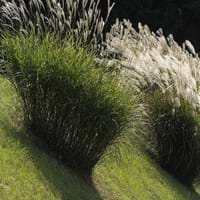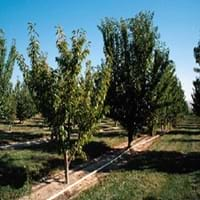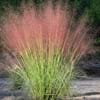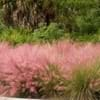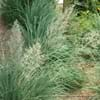Life Span
Perennial
Perennial
Origin
Hybrid origin
Hybrid origin, Western Asia
Types
Not Avaialble
Sweet cherry, Black cherry, Virginia bird cherry
Habitat
Lake Sides, savannahs
Terrestrial
USDA Hardiness Zone
5-9
5-8
Sunset Zone
1a, 1b, 2a, 3a, 3b, 4, 5, 6, 7, 8, 9, 10, 11, 12, 13, 14, 15, 16, 17, 18, 19, 20, 21, 22, 23, 24
4, 5, 6, 7, 15, 16, 17
Habit
Clump-Forming
Upright/Erect
Flower Color
Not Available
Not Available
Flower Color Modifier
Bicolor
Bicolor
Fruit Color
Not Available
Not Available
Leaf Color in Spring
Green
Not Available
Leaf Color in Summer
Light Green
Not Available
Leaf Color in Fall
Green, Purple, Burgundy, Bronze
Not Available
Leaf Color in Winter
Not Available
Light Green
Leaf Shape
Grass like
Oblong
Plant Season
Summer, Fall
Spring, Summer, Fall
Sunlight
Full Sun, Partial Sun
Full Sun, Partial Sun
Type of Soil
Clay, Loam, Sand
Clay, Loam, Sand
The pH of Soil
Acidic, Neutral
Acidic, Neutral
Soil Drainage
Average
Average
Bloom Time
Early Summer, Summer, Late Summer, Early Fall
Spring
Tolerances
Drought
Drought
Where to Plant?
Ground
Ground
How to Plant?
Rhizome division
Budding, Grafting
Plant Maintenance
Medium
Medium
Watering Requirements
Average Water Needs, Do Not over Water
Average Water Needs
In Summer
Lots of watering
Lots of watering
In Spring
Moderate
Moderate
In Winter
Average Water
Average Water
Soil pH
Acidic, Neutral
Acidic, Neutral
Soil Type
Clay, Loam, Sand
Clay, Loam, Sand
Soil Drainage Capacity
Average
Average
Sun Exposure
Full Sun, Partial Sun
Full Sun, Partial Sun
Pruning
Remove damaged leaves, Remove dead branches, Remove dead leaves
Prune in winter, Remove branches that rub together, Remove damaged leaves, Remove dead branches, Remove dead leaves, Remove dead or diseased plant parts
Fertilizers
All-Purpose Liquid Fertilizer
All-Purpose Liquid Fertilizer, Fertilize in early spring
Pests and Diseases
No serious insect or disease problems
Red blotch
Plant Tolerance
Drought
Drought
Flower Petal Number
Single
Not Available
Foliage Texture
Coarse
Not Available
Foliage Sheen
Glossy
Not Available
Attracts
Crickets
Aphids, Birds, Woodpeckers
Allergy
Not Available
Not Available
Aesthetic Uses
bank hedging, Mixed Border, Showy Purposes
Not Used For Aesthetic Purpose
Beauty Benefits
Not Available
Anti-ageing, Good for skin and hair, Promotes healthy skin, Skin cleanser
Environmental Uses
Air purification
Air purification, Food for birds, Food for insects, Nesting sites for birds, Shadow Tree, Windbreak
Medicinal Uses
No Medicinal Use
Anemia, anti-cancer, Arthritis, Cardiovascular problems, Migraines, Muscle Pain, Weight loss
Part of Plant Used
Whole plant
Fruits
Other Uses
Screen, Used as Biofuel, Used for making hedge
Food for animals, Food for insects, Used for its medicinal properties
Used As Indoor Plant
No
No
Used As Outdoor Plant
Yes
Yes
Garden Design
Hedges, Mixed Border, Screening / Wind Break
Edible, Fruit / Fruit Tree, Shade Trees, Topiary / Bonsai / Espalier
Botanical Name
MISCANTHUS Giganteus
PRUNUS avium 'Bing'
Common Name
Giant Silvergrass
Bing Cherry, Sweet Cherry
In Hindi
Giant Silvergrass
Bing Cherry Tree
In German
Riesenschilf
Bing Kirschbaum
In French
géant silvergrass
Bing Cherry Tree
In Spanish
Giant Silvergrass
Bing Cherry Tree
In Greek
Giant Silvergrass
Bing Cherry Tree
In Portuguese
Silvergrass gigante
Cherry Tree Bing
In Polish
Giant Silvergrass
Bing Cherry Tree
In Latin
Giant Silvergrass
Bing Cherry ligno
Phylum
Magnoliophyta
Magnoliophyta
Class
Lilopsida
Magnoliopsida
Clade
Angiosperms, Commelinids, Monocots
Angiosperms, Eudicots, Rosids
Tribe
Andropogoneae
Not Available
Subfamily
Panicoideae
Not Available
Number of Species
Not Available
Not Available
Importance of Giant Silvergrass and Bing Cherry
Want to have the most appropriate plant for your garden? You might want to know the importance of Giant Silvergrass and Bing Cherry. Basically, these two plants vary in many aspects. Compare Giant Silvergrass and Bing Cherry as they differ in many characteristics such as their life, care, benefits, facts, etc. Every gardener must at least have the slightest clue about the plants he wants to plant in his garden. Compare their benefits, which differ in many ways like facts and uses. The medicinal use of Giant Silvergrass is No Medicinal Use whereas of Bing Cherry is Anemia, anti-cancer, Arthritis, Cardiovascular problems, Migraines, Muscle Pain and Weight loss. Giant Silvergrass has beauty benefits as follows: Not Available while Bing Cherry has beauty benefits as follows: Not Available.
Compare Facts of Giant Silvergrass vs Bing Cherry
How to choose the best garden plant for your garden depending upon its facts? Here garden plant comparison will help you to solve this query. Compare the facts of Giant Silvergrass vs Bing Cherry and know which one to choose. As garden plants have benefits and other uses, allergy is also a major drawback of plants for some people. Allergic reactions of Giant Silvergrass are Not Available whereas of Bing Cherry have Not Available respectively. Having a fruit bearing plant in your garden can be a plus point of your garden. Giant Silvergrass has showy fruits and Bing Cherry has showy fruits. Also Giant Silvergrass is not flowering and Bing Cherry is flowering. You can compare Giant Silvergrass and Bing Cherry facts and facts of other plants too.
